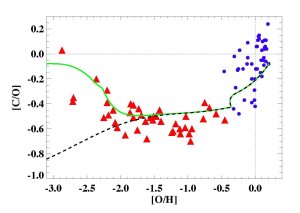 |
|
Fig. 1:
The team used the European Southern Observatory's Very Large Telescope (VLT) in Chile
to observe some of the oldest stars known in the Milky Way Galaxy. The VLT actually
consists of four different telescopes each with a main mirror diameter of 8.2 meter,
which makes them among the largest optical telescopes in the world.
Credit: Pierre Kervella (Paris-Meudon Observatory) and European Southern Observatory
|
 |
 |
|
Fig. 2:
Since the solar system is located inside the Milky Way Galaxy
one can not take an image of it from outside. This photo shows the nearest
large galaxy to the Milky Way, the Andromeda galaxy, which is very similar to our Galaxy.
Both are spiral galaxies, which consists of a disk and a central concentration of stars
called the bulge. The oldest stars are located in an extended halo around
the disk and bulge.
Credit: Robert Gendler
|
 |
 |
|
Fig. 3:
The y-axis show the ratio of carbon to oxygen abundances, [C/O],
as a function of oxygen content, [O/H], in the stars. Both [C/O] and [O/H]
are on a logarithmic scale relative to the Sun, which means that when for
example the ratio of carbon to oxygen is the same as the Sun then [C/O]=0,
while [C/O]=-1 means a factor of ten smaller ratio than in the Sun.
Similarly,
[O/H]=0 for the Sun but [O/H]=-3 for stars with only 1/1000th of the oxygen
abundance as the Sun. Since the oxygen content in the Milky Way Galaxy has
steadily increased with time, the x-axis can be seen as a time-axis: smaller
[O/H] means older stars. The red triangles show the new observations with the
Very Large Telescope while the blue circles denote solar-type stars in the
Galactic disk analysed by Bensby & Feltzing (2006). The increasing [C/O]
ratio towards lower [O/H] (older stars) is interpreted as a signature of
nucleosynthesis in the very first generation of stars (green solid line)
while models without accounting for this predict much too small [C/O] (black
dashed line).
|
|  |
All elements other than hydrogen and helium are forged by nuclear
reactions in the fiery interiors of stars. When stars die they eject
some of their nuclear-processed material to the interstellar medium
from which subsequent generations of stars are born, making the amount
of elements heavier than helium in the Universe to steadily increase
with time. Each element has its own characteristic origin in terms of
what type of stars produced it and when. For example, the oxygen we
breathe is thought to have been generated by stars with a mass more
than eight times that of the Sun while the carbon in our bodies is
believed to come from stars like our own Sun. Since solar-like stars
live for many billions of years, these stars would not have had time
to enrich their surroundings with carbon during the earliest cosmic
epochs when the Milky Way Galaxy was formed. The expectation would
then be that the astronomical fossils from this period -- the oldest
stars in the Galaxy surviving until now -- should contain relatively
little carbon.
Astronomers can determine the chemical composition of stars by
studying the radiation they emit with different elements producing
absorption lines at distinct wavelengths in the stellar
spectrum. Coupled with a realistic model for how the spectrum is
generated in the outer layers of stars, the stellar atmospheres, one
can then infer how much say carbon or iron a star contains. A team
led by PhD student Damian Fabbian from Australian National University
and Prof. Martin Asplund from Max Planck Institute for Astrophysics
has studied some of the oldest stars known in the Milky Way using
observations obtained with European Southern Observatory's Very Large
Telescope in Chile. In addition they have modelled the stellar
spectrum formation taking into account atomic processes not previously
considered, which makes the analysis more reliable.
To their surprise, the team members found that these very old stars
contained large amounts of carbon while at the same time less oxygen
than previous studies had claimed. In fact, the measured ratio of the
carbon abundance to the oxygen abundance in the most chemically
pristine of the stars studied is the same as for the Sun. The
observed carbon and oxygen atoms in the stars were produced in a
previous generation of stars, the very first stars born after the Big
Bang. These so-called first stars have never been observed directly as
they have now all died, but they must have been very different from
the stars existing today. Indeed, recent theoretical calculations of
the evolution of such stars imply that even very massive stars
containing initially only hydrogen and helium can produce the large
amounts of carbon observed. The new observations may therefore reveal
the tell-tale nuclear signature of the elusive first stars.
Martin Asplund
Publications
Damian Fabbian, Martin Asplund, Paul Barklem, Mats Carlsson and Dan Kiselman,
"Neutral oxygen spectral line formation revisited with new
collisional data: large departures from LTE at low metallicity",
2008, submitted to Astronomy & Astrophysics
Damian Fabbian, Poul Erik Nissen, Martin Asplund and Max Pettini,
"The [C/O] ratio at low metallicity: constraints on early chemical evolution
from observations of Galactic halo stars", 2008, submitted to Astronomy & Astrophysics
Damian Fabbian, "Chemical compositions of stars in the light of non-LTE
spectral line formation: the evolution of carbon and oxygen in the Galaxy",
2008, PhD thesis at the Australian National University
|